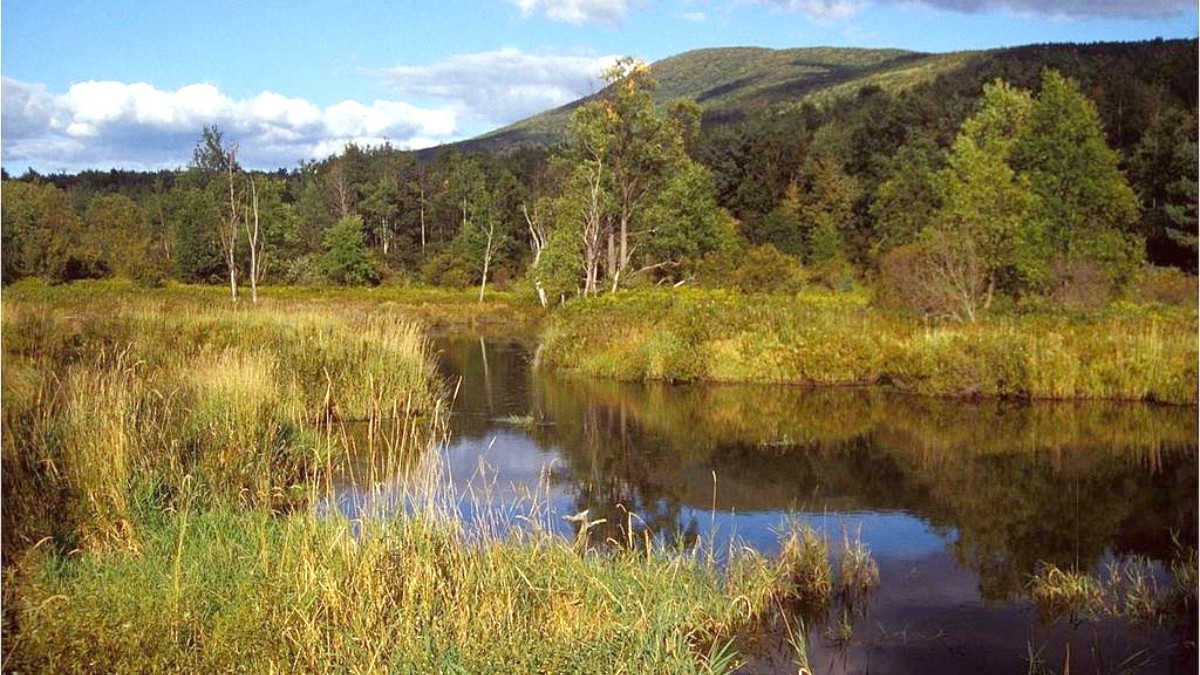
New York State, USA
Spring (April-May) temperatures typically range from the 40s to 60s Fahrenheit (4-15°C). The weather can be variable, with increasing rain. Snowmelt from higher elevations can lead to muddy trails. Nights remain cool. A fresh, green landscape emerges.
Summer (June-August) temperatures generally fall between the 60s and 80s Fahrenheit (15-27°C). Days can occasionally reach the 90s Fahrenheit (32°C). Humidity levels tend to be higher. Thunderstorms appear in the late afternoon. Forests offer shade and water activities coolness.
Summer (June-August) draws many visitors for warm weather. Pros: All outdoor activities. Cons: Higher prices, larger crowds, humidity.
Fall Foliage (Late Sept-Mid Oct) is celebrated for beauty. Pros: Crisp air, ideal for hiking. Cons: Peak crowds, highest accommodation prices, advance booking needed.
Late Dec-March
Ski resorts conditions are excellent. Landscapes are picturesque with snow. Enjoy cozy indoor activities.
Temperatures are cold. Road conditions can present challenge with snow and ice, extra caution.
April-May
Fewer crowds. Lower lodging prices. Late spring brings blooming wildflowers. Good for early fishing.
Weather can be variable. Trails can be muddy from snowmelt. Some attractions may have limited hours.
November-Early December
Very few crowds. Lowest accommodation prices. Quiet atmosphere. Early snowfall is an unique beauty.
Often "stick season" (bare trees). Shorter daylight hours. Some businesses may close temporarily between seasons.
Late spring, summer, and early fall present the best conditions for hiking. Fall views with foliage are most rewarding. Skiing and snowboarding runs from December through March for prime conditions at major resorts.
Spring (April-June) and Fall (September-October) are generally prime seasons for trout fishing. Summer water temperatures are ideal for river and lake activities like kayaking and tubing.
This period is busiest, so book accommodations and activities well ahead.
Expect resorts to fill up, especially on weekends and holidays.
Quieter periods with more flexibility for last-minute travel.
Look for special offers and packages during less busy times.
Monitor local weather and road conditions before daily outings.
Since the Catskills are in the United States, entry requirements follow standard federal U.S. Regulations.
Visitors from Visa Waiver Program (VWP) countries need an approved ESTA (Electronic System for Travel Authorization) before travel.
Specific documents are necessary for entry into the United States.
Costs vary widely depending on your travel style.
Detailed cost estimates for various travel styles.
Budget Traveler: $100 - $175 USD/day. Stays at campgrounds ($30), groceries for breakfast/lunch ($15), diner dinner ($25), gas contribution ($10), free hike ($0). Total: Around $80.
Accommodation: $50-$80 (campgrounds, basic motels, hostel dorms). Meals: $30-$50 (self-prepared, fast-casual, diners). Transportation: $10-$20 (limited bus, carpooling). Activities: $10-$25 (free hikes, town exploration).
Per night: Camping $25-$50. Motels $80-$150. Mid-range Hotels $150-$300. Luxury Resorts $300-$800+. Prices can exceed $800 during peak times.
Luxury resorts have higher prices during peak periods.
Per person: Breakfast $10-$20. Lunch $15-$30. Dinner (mid-range restaurant, excluding drinks) $30-$60. Coffee $3-$6. Craft Beer/Cocktail $7-$15.
Preparing some meals from grocery stores cuts costs.
Fine dining experiences lead to higher meal expenses.
Car Rental: $50-$150/day. Gasoline: $3.50-$5.00/gallon. Bus (NYC to Catskills, one-way): $30-$50. Attractions: State Park parking: Free-$10. Museums: $10-$25. Ski Lift: $70-$150+. Ziplining: $90-$150. Tubing/Kayaking Rentals: $30-$70.
Focus on free outdoor activities for budget travel.
Ski lift tickets and guided tours contribute to higher daily costs.
| Strategy | Details | Benefit |
|---|---|---|
| Travel During Shoulder Seasons | Spring (April-May) and late fall (Nov-Early Dec) offer lower prices and fewer crowds. | Enjoy natural beauty without premium costs. |
| Pack Your Own Meals | Bring lunches and snacks for hikes. Grocery stores in larger towns offer good selections. | Avoid higher prices at cafes or tourist traps. |
| Utilize Free Outdoor Activities | Hiking, scenic drives, exploring town centers, and public parks cost little to nothing. | A wealth of free experiences. |
The region is generally safe, but awareness of common risks helps you stay prepared.
Wear long sleeves and pants (Socks), use Insect repellent with DEET or picaridin, Permethrin-treated clothing. Perform tick checks. Mosquito-borne (West Nile Virus): Use repellent.
Apply Sunscreen SPF 30+, wear a Wide-brimmed hat and Sunglasses. For poison ivy: Learn to identify ("leaves of three"), wear long pants. If contact, wash affected area with soap and water (Hydrocortisone cream may help).
Hypothermia (cold): Dress in layers, avoid cotton, carry extra warm clothing. Heatstroke (warm): Hydrate well, avoid strenuous activity during hottest parts of day.
Dial 911 for all emergencies (police, fire, ambulance).
Good access to healthcare in larger Catskills towns. Hospitals and urgent care centers are available. Tap water is generally safe to drink. Restaurants adhere to high food hygiene standards.
No specific vaccinations are required for entry to the U.S. Ensure routine vaccinations are current. An annual flu shot is recommended.
Comprehensive travel insurance is highly recommended. Explore options with World Nomads, SafetyWing, or Insubuy.
Generally low crime rates. Petty theft can occur at trailheads. Secure valuables out of sight, lock your car.
Winter: Heavy snowfall, ice storms. Spring/Summer: Flash flooding, thunderstorms (seek indoor shelter). Fall: Wildfires during dry periods. Power outages can occur during severe weather.
Emergency Services: Dial 911. Poison Control: 1-800-222-1222. Carry physical list of emergency contacts. Make digital copies of passport, visa, insurance.
Always consult your healthcare provider before international travel for personalized health advice.
Exercise common sense, just as you would in any unfamiliar area.
Perform thorough tick checks after outdoor activities.
Use sunscreen, hats, and sunglasses regularly.
Do not leave bags unattended in public areas.